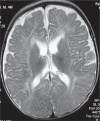Neuroradiological, neurophysiological and molecular findings in infantile Krabbe disease: two case reports
- PMID: 27785412
- PMCID: PMC5026284
- DOI: 10.1515/bjmg-2016-0011
Neuroradiological, neurophysiological and molecular findings in infantile Krabbe disease: two case reports
Abstract
Krabbe disease is an autosomal recessive neurodegenerative disorder due to a defect of the lysosomal enzyme β-galactocerebrosidase (β-GALC). Depending on the age of onset, the disease is classified into infantile and later-onset forms. We report neuroradiological, neurophysiological and molecular findings in two Greek patients with the infantile form of Krabbe disease. The index patients presented at the age of 3.5 and 6 months, respectively, due to developmental delay. Magnetic resonance imaging (MRI) of the first patient's brain demonstrated signs of leukodystrophy, while nerve conduction velocities (NCVs) were significantly decreased. The second patient's MRI at the age of 4 months was initially normal, but at 18 months demonstrated leukodystrophic alterations as well, whereas NCVs were also significantly delayed. In both patients, a severe decrease in β-GALC, activity supported the diagnosis of Krabbe disease, while the final diagnosis was confirmed by molecular genetic testing. Two homozygous mutations of the GALC gene, the c.411_413delTAA [p.K139del] mutation in the first patient, and the c.749T>C [p.I250T] mutation in the second patient, were identified. At their last follow-up visit at the age of 4 and 6 years, respectively, both patients were bedridden and quadri-plegic, suffering from frequent respiratory tract infections and fed through a gastrostomy. Both mutations found in homozygosity in these two unrelated patients of Greek ancestry, could pinpoint a common origin. Genotyping of patients with Krabbe disease is important, in order to contribute to the creation of a European mutation database and to further study possible genotype-phenotype correlations of the disease.
Keywords: GALC gene; Krabbe disease; Leukodystrophy; Mutation; Nerve conduction velocity (NCV); β-galactocerebrosidase (β-GALC).
Figures


Similar articles
-
Pathogenic Variants in GALC Gene Correlate With Late Onset Krabbe Disease and Vision Loss: Case Series and Review of Literature.Front Neurol. 2020 Oct 15;11:563724. doi: 10.3389/fneur.2020.563724. eCollection 2020. Front Neurol. 2020. PMID: 33178108 Free PMC article.
-
The Spectrum of Krabbe Disease in Greece: Biochemical and Molecular Findings.JIMD Rep. 2016;25:57-64. doi: 10.1007/8904_2015_457. Epub 2015 Jun 25. JIMD Rep. 2016. PMID: 26108647 Free PMC article.
-
Clinical and molecular findings in 6 Turkish cases with Krabbe disease.Turk J Pediatr. 2022;64(1):69-78. doi: 10.24953/turkjped.2020.3713. Turk J Pediatr. 2022. PMID: 35286032
-
Insights into the Pathogenesis and Treatment of Krabbe Disease.Pediatr Endocrinol Rev. 2016 Jun;13 Suppl 1:689-96. Pediatr Endocrinol Rev. 2016. PMID: 27491217 Review.
-
Advances in the Diagnosis and Treatment of Krabbe Disease.Int J Neonatal Screen. 2021 Aug 18;7(3):57. doi: 10.3390/ijns7030057. Int J Neonatal Screen. 2021. PMID: 34449528 Free PMC article. Review.
Cited by
-
A novel homozygous GALC variant has been associated with Krabbe disease in a consanguineous family.Neurol Sci. 2018 Dec;39(12):2123-2128. doi: 10.1007/s10072-018-3556-2. Epub 2018 Sep 12. Neurol Sci. 2018. PMID: 30209698
-
Spontaneous Third Ventriculostomy in Krabbe Disease.Pediatr Neurol. 2020 Jul;108:99-105. doi: 10.1016/j.pediatrneurol.2019.11.014. Epub 2019 Dec 2. Pediatr Neurol. 2020. PMID: 32197817 Free PMC article.
-
Krabbe Disease: Report of a Rare Lipid Storage and Neurodegenerative Disorder.Cureus. 2017 Jan 1;9(1):e949. doi: 10.7759/cureus.949. Cureus. 2017. PMID: 28168127 Free PMC article.
References
-
- Spiegel R, Bach G, Sury V, Mengistu G, Meidan B, Shalev S, et al. A mutation in the saposin A coding region of the prosaposin gene in an infant presenting as Krabbe disease: First report of saposin A deficiency in humans. Mol Genet Metab. 2005; 84(2): 160-166. - PubMed
- Spiegel R, Bach G, Sury V, Mengistu G, Meidan B, Shalev S. et al. A mutation in the saposin A coding region of the prosaposin gene in an infant presenting as Krabbe disease: First report of saposin A deficiency in humans. Mol Genet Metab. 2005;84(2):160–166. - PubMed
-
- Szymanska K, Lugowska A, Laure-Kamionowska M, Bekiesinska-Figatowska M, Gieruszczak-Bialek D, Musielak M, et al. Diagnostic difficulties in Krabbe disease: A report of two cases and review of literature. Folia Neuropathol. 2012; 50(4): 346-56. - PubMed
- Szymanska K, Lugowska A, Laure-Kamionowska M, Bekiesinska-Figatowska M, Gieruszczak-Bialek D, Musielak M. et al. Diagnostic difficulties in Krabbe disease: A report of two cases and review of literature. Folia Neuropathol. 2012;50(4):346–56. - PubMed
-
- Suzuki K. Twenty five years of the “psychosine hypothesis”: A personal perspective of its history and present status. Neurochem Res. 1998; 23(3): 251-259. - PubMed
- Suzuki K.. Twenty five years of the “psychosine hypothesis”: A personal perspective of its history and present status. Neurochem Res. 1998;23(3):251–259. - PubMed
-
- Debs R, Froissart R, Aubourg P, Papeix C, Douillard C, Degos B, et al. Krabbe disease in adults: Phenotypic and genotypic update from a series of 11 cases and a review. J Inherit Metab Dis. 2013; 36(5): 859-868. - PubMed
- Debs R, Froissart R, Aubourg P, Papeix C, Douillard C, Degos B. et al. Krabbe disease in adults: Phenotypic and genotypic update from a series of 11 cases and a review. J Inherit Metab Dis. 2013;36(5):859–868. - PubMed
LinkOut - more resources
Full Text Sources
Other Literature Sources
